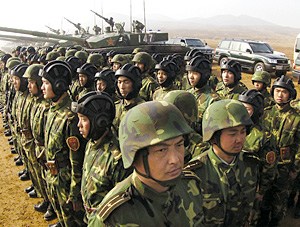INDIAN ARMED FORCES CHIEFS ON OUR RELENTLESS AND FOCUSED PUBLISHING EFFORTS

The insightful articles, inspiring narrations and analytical perspectives presented by the Editorial Team, establish an alluring connect with the reader. My compliments and best wishes to SP Guide Publications.

"Over the past 60 years, the growth of SP Guide Publications has mirrored the rising stature of Indian Navy. Its well-researched and informative magazines on Defence and Aerospace sector have served to shape an educated opinion of our military personnel, policy makers and the public alike. I wish SP's Publication team continued success, fair winds and following seas in all future endeavour!"

Since, its inception in 1964, SP Guide Publications has consistently demonstrated commitment to high-quality journalism in the aerospace and defence sectors, earning a well-deserved reputation as Asia's largest media house in this domain. I wish SP Guide Publications continued success in its pursuit of excellence.
- Appointments Committee of Cabinet approves one-month extension in service of Chief of the Army Staff
- Admiral Dinesh K. Tripathi assumes Command of the Indian Navy as 26th Chief of the Naval Staff
- Prime Minister witnesses 'Bharat Shakti' – a Tri-Services Firing and Manoeuvre Exercise in Pokhran, Rajasthan
- Interim Defence Budget 2024-25 — An Analysis
- Union Defence budget 2024
- Prime Minister Modi Commemorates Indian Navy Day in a Grand Ceremony
China’s military might increasing: Report

China’s military is modernising, but the Chinese Government needs to be more forthcoming on why it needs these new capabilities, according to a Defence Department report
Michael Schiffer, Deputy Assistant Secretary of Defense for East Asia, said the United States “welcomes a strong, prosperous and successful China that contributes to international rules and norms and enhances security and peace both in the Asia-Pacific region and around the globe.”
The United States is working to engage China in economic, peacekeeping and humanitarian areas, among others. A good military-to-military relationship is one part of that engagement and China is working with the international community, for example, to counter piracy off the coast of Somalia and in the Gulf of Aden. The Chinese military also has contributed to earthquake relief in Pakistan and played a role in delivering humanitarian aid to Haiti.
“However,” says the report, “the pace and scope of China’s sustained military investment have allowed China to pursue capabilities that we believe are potentially destabilising to regional military balances, increase the risk of misunderstanding and miscalculation, and may contribute to regional tensions and anxieties.”
The capabilities could pose a temptation for the Chinese Government to use military force “to gain diplomatic advantage, advance its interests, or resolve disputes in its favour”. This danger re-emphasises the need for a sustained and reliable military-to-military dialogue between the United States and China.
China’s army is on track to realise its goal of building a modern, regionally focused military by 2020, the report says. But China’s ability to sustain military power at a distance today remains limited.
This month, China has conducted sea trials of a Kuznetsov class aircraft carrier it purchased from Ukraine and refurbished. “The aircraft carrier could become operationally available to China’s navy by the end of 2012, we assess, but without aircraft. It will take a number of additional years for an air group to achieve the sort of minimal level of combat capability aboard the carrier that will be necessary for them to start to operate from the carrier itself.”
The Chinese continue to invest in submarines, and China’s navy is investing in new surface combatants designed for antisurface and anti-air warfare and construction of a major naval base on Hainan Island is complete. “And this base, we assess, is large enough to accommodate a mix of ballistic missiles, submarines and large surface combatants, including aircraft carriers.”
China is also investing in aircraft and missiles. In January, the Chinese air force flight-tested its next-generation fighter prototype. The aircraft includes stealth attributes, advanced avionics and supercruise-capable engines.
Space also is a focus of China’s military modernisation, with a record 15 launches in 2010.
While relations with Taiwan and China have improved markedly, the Chinese military still focuses on a cross-strait contingency. China also seems to be stressing maritime territorial claims in the South China Sea – an area where roughly 50 per cent of the world’s trade travels. The Chinese military also has demonstrated in recent years the capability to conduct limited peacetime deployments of modern forces outside Asia.
“This includes multiple counterpiracy deployments to the Gulf of Aden and increasing participation in international humanitarian and disaster … relief efforts. Investments in large amphibious ships, a new hospital ship, long-range transport aircraft and improved logistics have made these sorts of missions a practical reality.”
The modernisation shows no sign of slowing as the Chinese military received a 12.7 per cent budget increase this year. The report acknowledges the difficulty in figuring how much China spends on its military, but estimates it at around $165 billion ( Rs. 7,42,500 crore). “That continues more than two decades of sustained budgetary growth.”
The Chinese have made some incremental improvements in transparency in recent years, but a number of uncertainties remain.
“We will continue, and we do continue, to encourage China to improve transparency and openness, to act in ways that support and strengthen common political, economic and diplomatic interests of the region and of the international community,” Schiffer said.





